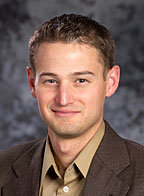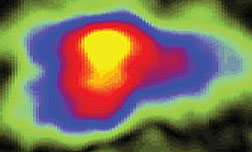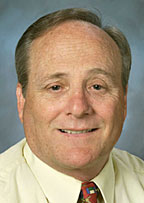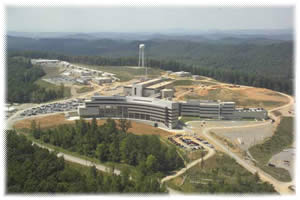| Research
|
|
|||||||||||||||||||||||||||
|
Check out the joint Fermilab/SLAC publication symmetry.
|
Millions of computer hours
|
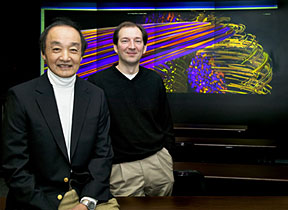 |
|---|
PPPL Chief Scientist Bill Tang (left) and PPPL computational scientist Stephane Ethier are at the Lab's High-Resolution Wall. In the background is a plasma turbulence simulation. |
William Tang, chief scientist at DOE's Princeton Plasma Physics Laboratory, has been awarded two million processor hours on the new IBM Blue Gene/P supercomputer at the Argonne National Laboratory. He and PPPL computational scientist Stephane Ethier will be using the time for fusion energy related research.
Tang heads one of 55 scientific projects recently awarded a total of 265 million hours by the DOE's Office of Science through the 2008 Innovative and Novel Computational Impact on Theory and Experiment (INCITE) program.
“The Department of Energy's Office of Science has two of the top ten most powerful supercomputers, and using them through the INCITE program is having a transformational effect on America's scientific and economic competitiveness,” DOE Under Secretary for Science Raymond L. Orbach said.
Tang's project focuses on gaining a better understanding of turbulence as a primary mechanism by which particles and energy diffuse across the confining magnetic field in toroidal fusion systems. Results from these studies may have direct relevance to the future performance of the international fusion experiment called ITER being planned for construction in France. Plasma is a hot, gaseous state of matter used as the fuel to produce fusion energy — the power source of the sun and the stars. This INCITE project will commence within the next month and extend over a year, with expected renewals in the subsequent two years.
“My colleagues and I are grateful for the INCITE award and are excited by the opportunity to use the new IBM Blue Gene/P at Argonne National Laboratory to accelerate the pace to fresh scientific insights about the complex nature of turbulence in hot thermonuclear plasmas,” said Tang.
Ethier noted that a research project requiring two million processor hours would take 228 years to complete using a single processor. “With 100,000 processors working in parallel — the final configuration of the Blue Gene/P supercomputer at the Argonne National Laboratory — the same two million processor-hour calculations will take only 20 hours. The real challenge is to orchestrate the work and the communication among these 100,000 processors. If a single processor falls behind, it will slow down the others since they must work in unison. As the number of processors increases, keeping them in sync becomes quite arduous,” he said.
Co-investigators on the project are Scott Klasky of DOE's Oak Ridge National Laboratory (ORNL) in Tennessee and Mark Adams of Columbia University in New York.Submitted by DOE's
Princeton Plasma
Physics Laboratory
